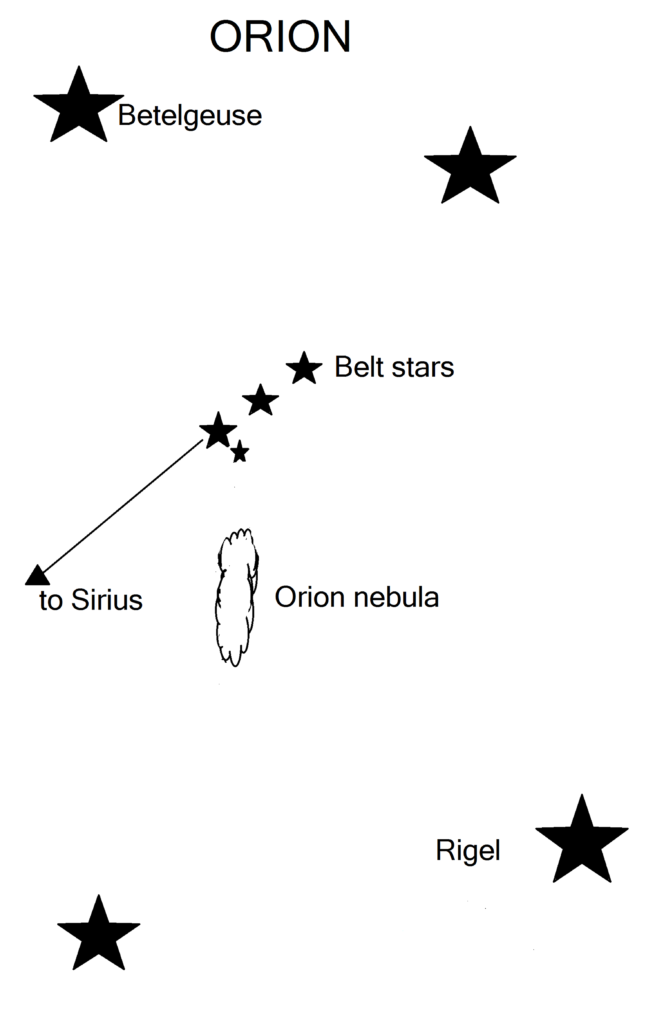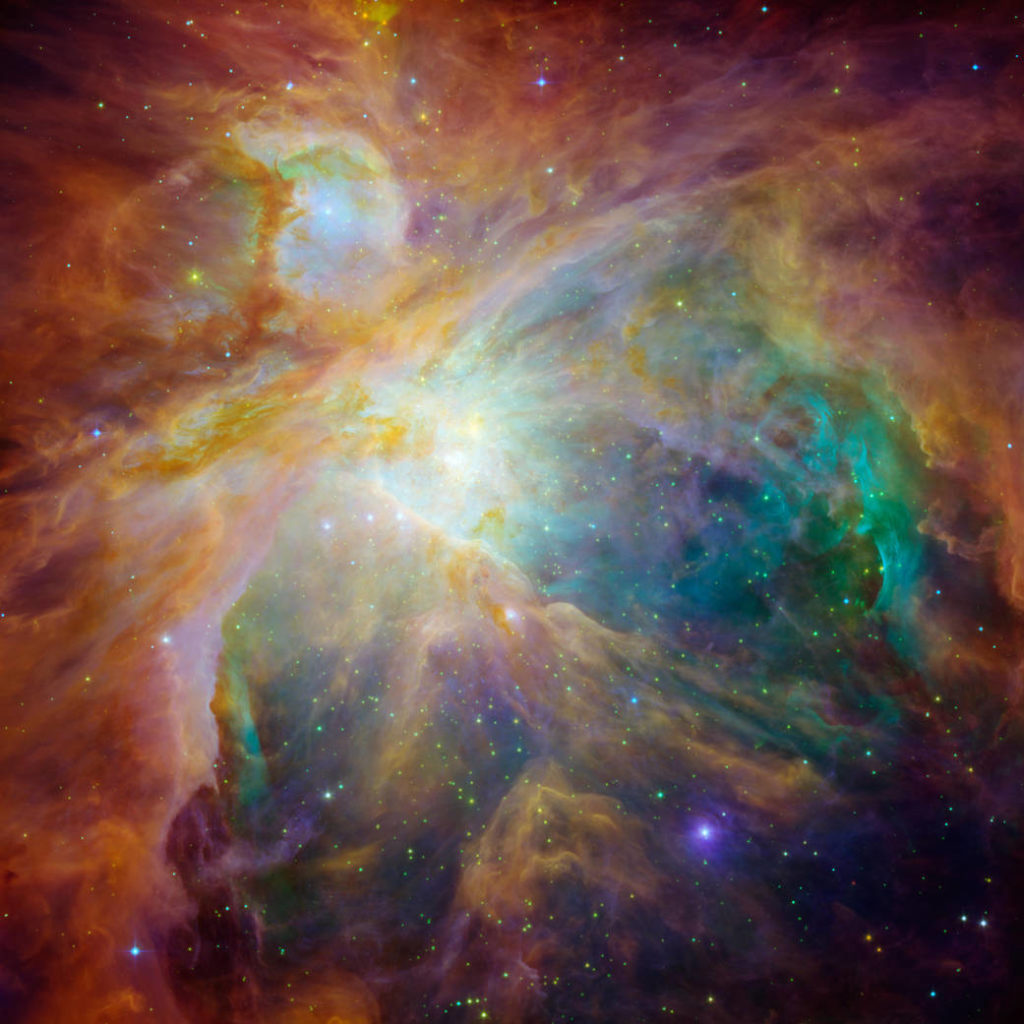Night Sky: Orion the Hunter
by Dee Sharples –
Orion the Hunter a majestic and easily recognized constellation soars across the sky during February.
 If you’re not already familiar with Orion, its distinct pattern of bright stars makes it very easy to identify. Around the middle of February, at 9:00 pm, face due south and measure up 40 degrees (4 fist widths-see side bar below) from the horizon. Look for the three stars which make up Orion’s belt. These stars are fairly bright and lay in a straight line spaced equidistance apart and are approximately the same magnitude at 1.8, 1.7 and 2.2. Above and to the high left is the bright red supergiant star Betelgeuse which marks Orion’s shoulder. Betelgeuse has a distinctly reddish hue compared to other stars in the sky. The same distance below the belt stars but angled toward the right is Rigel, a bright blue-white star which represents Orion’s knee. Two other bright stars complete Orion’s telltale shape as shown on the star chart.
If you’re not already familiar with Orion, its distinct pattern of bright stars makes it very easy to identify. Around the middle of February, at 9:00 pm, face due south and measure up 40 degrees (4 fist widths-see side bar below) from the horizon. Look for the three stars which make up Orion’s belt. These stars are fairly bright and lay in a straight line spaced equidistance apart and are approximately the same magnitude at 1.8, 1.7 and 2.2. Above and to the high left is the bright red supergiant star Betelgeuse which marks Orion’s shoulder. Betelgeuse has a distinctly reddish hue compared to other stars in the sky. The same distance below the belt stars but angled toward the right is Rigel, a bright blue-white star which represents Orion’s knee. Two other bright stars complete Orion’s telltale shape as shown on the star chart.
The belt stars will help you find the Orion Nebula, also known as Orion’s sword which hangs from his belt. It will be easiest under a dark, moonless sky. Look below the left-most belt star for a few faint stars angled downward and a smudge of light surrounding them. Remember to use your “averted vision” when scanning for a faint object. That means when you think you see it, you shouldn’t look directly at it but off to the side or above or below it. The receptors in your averted vision are more sensitive in the dark than if you look directly at an object. This is the Orion Nebula, a stellar nursery where new stars are forming and being born today. This large area of gas and dust is illuminated by four bright young nearby stars only about a million years old. In comparison, our Sun, is a 4.5 billion year old star.

If you have a pair of binoculars, use them to look more closely at the nebula. Even a small amount of magnification will show details in its delicate beauty.
Go back to the belt stars and now follow them down and to the left in a straight line until you see an extremely bright star near the horizon. This is Sirius, the Dog Star, which is part of the constellation Canis Major, the greater dog. Orion has two dogs which follow him across the sky – the other is Canis Minor, the lesser dog.
Sirius is the brightest star in the night sky from anywhere on Earth at magnitude -1.46. Its extreme brightness and its position near the horizon work together to give Sirius the appearance that it’s twinkling more than any other star in the night sky. The light from Sirius has to travel through the densest part of our atmosphere, a very turbulent atmosphere filled with dust particles which distorts the light as it passes through causing it to twinkle and even change color.
Because Earth revolves around the Sun once every year, each night the stars reach the same position in our sky 4 minutes earlier. This adds up to 2 hours earlier each month. That means you can look for Orion due south at 10:00 pm on February 1st, 9:00 pm on February 15th, and 8:00 pm on February 28th. If you’d rather view Orion earlier in the evening, look toward the southeast as it rises around 6:30 pm at the beginning of the month. Orion will appear to be tipped to the left as he begins his journey across the night sky.
For still another month you’ll have to get up before the Sun if you’d like to view some planets. Brilliant Jupiter shining at magnitude -2.2 will be 30 degrees up from the horizon around 5:00 am. On February 7th, the Moon will pass just to Jupiter’s upper right. On February 8th, the Moon can be found between Jupiter and the dimmer planet Mars which will shine at only magnitude 1.0. On February 9th, the Moon will have moved to 5 degrees to the upper left of Mars. Notice that Mars has a more ruddy color compared to Jupiter. The Moon will be a great guidepost to help you find these planets which would otherwise appear to be just more stars.
The crisp winter skies will offer some beautiful sights this month but be sure to dress very warm if you want to enjoy them.
See the sidebar (below) for an explanation of magnitudes and how to measure degrees.
_________________
Magnitude: Measures the apparent brightness of a celestial object and is expressed by a decimal. The larger the number, the dimmer the object.
Sun: -26.7
Full Moon: -12.6
Sirius, the Dog Star: -1.46
Bright star: 0.0
Dimmest star visible with the unaided eye: 6.0
How to measure degrees in the sky: A simple “ruler” is to hold your arm straight out and make a fist. The area of the sky covered by your fist measures roughly 10 degrees. By moving your fist and counting how many “fist widths” it takes to reach an object in the sky, you’ll have an approximation of degrees.
 Dee Sharples is an amateur astronomer who enjoys observing planets, star clusters and the Moon through her telescope. She is a member of ASRAS (Astronomy Section of the Rochester Academy of Science) and records “Dee’s Sky This Month”, describing what can be seen in the sky, on the ASRAS website at rochesterastronomy.org. Watch for her monthly Owl Light News feature to learn more about the night sky.
Dee Sharples is an amateur astronomer who enjoys observing planets, star clusters and the Moon through her telescope. She is a member of ASRAS (Astronomy Section of the Rochester Academy of Science) and records “Dee’s Sky This Month”, describing what can be seen in the sky, on the ASRAS website at rochesterastronomy.org. Watch for her monthly Owl Light News feature to learn more about the night sky.